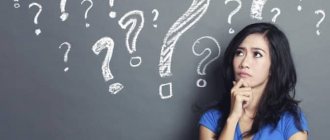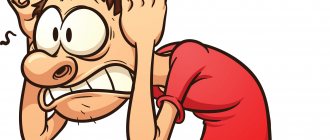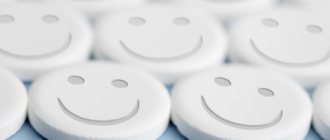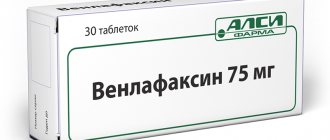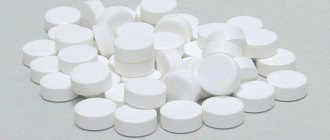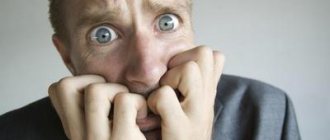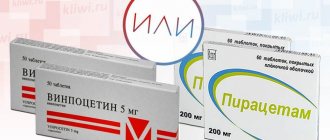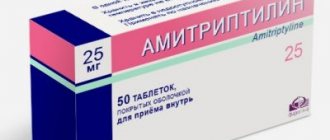Tranquilizers are classified as psychotropic drugs, since the main target of their action is the mental sphere and they are used to treat mental illnesses and painful conditions in healthy individuals. In addition to tranquilizers, psychotropic drugs include antipsychotics, antidepressants, mood stabilizers, nootropics and nervous system stimulants.
The first tranquilizer MEPROBOMAT
was synthesized in 1952. Thus, the history of the use of drugs in this group goes back more than 60 years.
Most drugs in this group, in addition to their sedative effect, have the ability to reduce muscle tension, make it easier to fall asleep, and stabilize autonomic reactions: palpitations, pressure surges, tremors, dizziness and headaches.
Tranquilizers
- a large group of drugs that are different in structure and mechanism of action, but what they have in common is a decrease in the excitability of the subcortical structures of the brain responsible for emotional reactions.
General restrictions for all drugs in this group are incompatibility with alcohol (they enhance each other’s effects), and prohibition on use by persons performing complex responsible actions that require increased concentration and instant reaction (drivers, pilots, machine operators, etc.) .
Depending on the chemical structure, tranquilizers are divided into several groups (according to M.D. Mashkovsky). List of tranquilizers by group:
Mechanism of action
Tranquilizers are psychotropic drugs used to treat overexcitation of the nervous system, temporarily eliminating fear, suppressing emotions, and correcting sleep.
Only doctors use such medications; medications can only be purchased at a pharmacy with a prescription. In medical practice today, a distinction is made between major and minor tranquilizers. The first are neuroleptics, potent psychotropics. The second are anxiolytics, these are the drugs that act much more gently and relieve anxiety and fear.
Any anxiolytic “works” at the level of the brain centers responsible for the formation of human emotions. Benzodiazepine representatives of the group have been studied better than others. Receptors of this series are closely connected in the brain with GABA (gamma-aminobutyric acid) receptors, which is responsible for inhibition processes in the central nervous system.
Anxiolytic drugs from other pharmaceutical groups bind to other receptors (for example, serotonin, acetylcholine, adrenaline) and do not use GABA, but the main effect remains the same - the relief of anxiety. In other words, drugs in this group of drugs can have a number of effects:
- anxiolytic – anti-anxiety;
- hypnotic - sleeping pills;
- sedative – calming;
- anticonvulsant – antiepileptic;
- muscle relaxant – relaxing, relieving motor tension.
When will antidepressants help?
The translation of the word antidepressant has a triple meaning and is translated as “soul”, “mood”, “retracting”. Their main purpose is to treat depression. When introduced into the body, the production of neurotransmitters increases: dopamine, serotonin, norepinephrine.
Antidepressants and tranquilizers are prescribed for some similar symptoms:
- depression in all its manifestations;
- manic-depressive psychosis;
- phobic disorders;
- in case of alcoholism, substance abuse, drug addiction;
- with anorexia or bulimia;
- functional enuresis.
Antidepressants (thymoanaleptics) have a sedative (calming) or stimulating (activation) effect on the psyche. It all depends on the specific drug that is prescribed to the client. Their mechanism of action is different, on the basis of which the classification of psychotropics is based:
- MAO inhibitors stop the synthesis of monoamine oxidase (enzyme), which destroys “happy hormones”. These include tetrindole, incasan, befol, moclobemide (aurorix).
- Tricyclics are prescribed for apathy: mitriptyline, clomipramine, dibenzepine and doxepin
- SSRIs or selective serotonin reuptake inhibitors are most often prescribed because drugs in this group are easier to tolerate and compensate for the lack of “happy hormones.” These are fluoxetine, paroxetine, sertraline, escitalopram.
- Psychotropics of other groups: mirzaten, coaxil.
Important! Antidepressants are potent drugs and an individual choice of drug is required for each client. The dosage and duration of use is controlled by a doctor. Self-medication is unacceptable, since psychotropics of this group have a large number of side effects.
Tranquilizers: what are these drugs and how do they affect the body?
Feelings of anxiety, restlessness, and irritability distract you from everyday activities, unsettle you, and interfere with your normal lifestyle. Often these feelings do not have any real basis, and this causes even more harm.
A person, even understanding in the depths of his soul that he needs to calm down, pull himself together and soberly assess the current situation, physically cannot do this. In cases where fear, panic, anxiety are the result of stress or depression, qualified help is needed.
The pharmaceutical industry quickly responds to changes in lifestyle, providing modern people with the tools to help them get back on track and lead a normal life.
Most often, treatment is carried out in short courses; self-medication, even when purchasing tranquilizers without a prescription, is strictly not recommended.
Classification
There is no unified clinical classification of tranquilizers due to the constant expansion of the list of drugs that have borderline properties. However, for the convenience of practicing physicians, several main groups of minor psychotropics are distinguished.
Based on the strength of the effect on the central nervous system, they are distinguished:
- sedatives that improve sleep, slightly inhibiting excitation processes in the neurons of the brain;
- anxiolytics or true tranquilizers;
- neuroleptics are the “heavy artillery” used in psychiatry.
According to their chemical structure, anxiolytics can be benzodiazepines, diphenylmethane derivatives, carbamates, and others (miscellaneous).
The most common drugs are benzodiazepines, which in turn are divided into:
- anxiolytics: strong (Diazepam, Alprazolam, Phenazepam, Lorazepam) and moderate (Bromazepam, Oxazepam, Gidazepam, Clobazam);
- tranquilizers with a hypnotic effect (Triazolam, Flunitrazepam, Midazolam, Nitrazepam, Estazolam);
- drugs that can stop seizures (Diazepam, Clonazepam).
A separate group consists of daytime tranquilizers that do not have a hypnotic effect. The drugs, being a type of benzodiazepines, act more mildly. Using group medications for treatment, patients do not change their usual lifestyle. These include: Gidazepam, Grandaxin, Medazepam and Oxazepam.
New generation tranquilizers form their own group of drugs. Their absolute advantage is the complete absence of addiction. The downside is a weak, short-lived result, many side effects. An example would be: Adaptol, Atarax, Afobazol.
What types of tranquilizers are there?
The list of drugs is quite extensive and includes drugs of varying intensity. The classification is based on the active substance and the effect it has on the body.
This group includes derivatives of various chemical groups. These include:
- hydroxyzine,
- benactizine,
- meprobamate.
They are prescribed for asthenic and neurotic reactions, anxiety syndrome, mild phobias and depression, neurodermatitis, and sleep disorders. Hydroxyzine is well tolerated with long-term use and is not addictive.
This group includes strong drugs, which include:
- Benzodiazepine drugs - phenazepam, seduxen, lorafen, nozepan. Medicines and “heavy artillery” discharges are dispensed by prescription with a doctor’s prescription.
- Derivatives of different chemical groups - afobazole, proroxan. Unlike benzodiazepine drugs, afobazole and proroxan are not addictive and have no side effects - lethargy, distraction, decreased reaction, emotional dullness. They reduce anxiety, improve sleep, relieve nervous tension, and reduce the manifestation of autonomic disorders.
These are light tablets, the use of which does not have a significant effect on memory, attention, or reaction. This group includes:
- Benzodiazepine drugs – Grandaxin, Rudotel, Adaptol. These medications do not have a sedative effect; on the contrary, they stimulate the nervous system and do not cause dependence or withdrawal symptoms.
- Derivatives of different chemical groups - spitomin, phenibut. The use of drugs is advisable for depressive and panic disorders, anxiety syndrome, and disorders of the autonomic nervous system. Not used as a sedative, muscle relaxant or hypnotic. They do not affect reaction, memory, attention, and do not depend on the effects of alcohol. Phenibut speeds up reaction speed and attention. Since withdrawal syndrome is not observed, medications are taken in long courses, they have a cumulative effect and the maximum therapeutic effect is achieved 4 weeks after the start of treatment.
- Diphenylmethane derivatives – atarax, amizil. The drugs reduce muscle tension, normalize sleep, and do not cause addiction.
- Derivatives of different chemical groups - buspirone, etifoxine, hydroxymethylethylpyridine succinate. This group of drugs is considered the best in the treatment of anxiety. They have versatile activity, in some cases they are allowed during pregnancy and in pediatrics.
Trimetozin
A moderate tranquilizer that does not cause drowsiness or lethargy. After taking the tablet, there is no suppression of reflexes, and there is no muscle relaxant effect. The medicine is well tolerated and is often prescribed to patients in the hospital.
When taking large doses, side effects appear in the form of mild nausea, allergies, tension, and feelings of fear. The product is indicated for internal use after meals.
Purpose principles
Symptoms indicating the need to take tranquilizers:
- Fear
- Panic attacks
- Increased anxiety
- Mood swings, irritability, nervousness
- Sleep disorders
When choosing a drug, the question often arises: what is the difference between tranquilizers and antidepressants? If we talk about first-generation drugs and strong tranquilizers, their long-term use causes dependence and addiction, followed by withdrawal symptoms.
What is better, tranquilizers, antidepressants or antipsychotics, is decided by the doctor in each case.
Tranquilizers of each subgroup treat specific negative symptoms. The drugs are used for a large number of pathologies, which are completely impossible to list. The most common reasons for prescribing anxiolytics are neurogenic pathologies, VSD, panic attacks, fear, anxiety, stress, neurosis-like conditions, PMS, menopause, as well as:
- psychosomatics: peptic ulcer, hypertension, cardiac ischemia, other pathologies;
- post-traumatic disorders;
- convulsions, including epileptic ones;
- chronic alcoholism, drug addiction, substance abuse;
- uncontrolled motor activity: hyperkinesia, tics, blepharospasm, myoclonus, and so on;
- spastic muscle conditions;
- premedication;
- insomnia;
- itchy skin;
- emotional instability.
Since anxiolytics are classified as psychotropic drugs, that is, their point of application is brain cells, medications should be prescribed according to certain principles:
- doses of medications are minimal;
- courses of therapy are short (no more than a month) to avoid addiction;
- gradual withdrawal of funds;
- during therapy - a complete ban on alcohol;
- the course of treatment involves giving up driving and working on machines, equipment, and devices that require quick reactions.
The variety of pharmacological groups, which include anxiolytics, and a wide range of drugs suggest individual restrictions on taking medications. But there are also general contraindications to the use of this subgroup of psychotropics:
- individual intolerance to components;
- pregnancy and breastfeeding;
- myasthenia gravis;
- glaucoma;
- renal, hepatic failure;
- respiratory failure;
- any type of addiction;
- depression (for benzodiazepine tranquilizers).
Tranquilizers without prescriptions
Some drugs that reduce anxiety and fear and stimulate the nervous system can be bought at the pharmacy without a prescription. These include
- rudotel,
- zoloft,
- atarax,
- tofisopam,
- phenazepam,
- etifoxine,
- paxil
Drugs –
- buspirone,
- adaptol,
- atarax,
- afobazole,
- etifoxine,
- cuts,
- amizil,
- Mexidol,
- oxylidine,
- phenibut
are not addictive and do not have withdrawal symptoms. They are easily tolerated by the body and can be combined with medications from other groups.
Daytime medications
Grandaxin, gidazepam, medazepam, trimetozin, trioxazine, prazepam have a pronounced anti-anxiety effect, but do not have muscle relaxant, sedative and hypnotic effects.
Taking these medications is advisable for mild anxiety and does not affect reaction speed or attention.
Since psychotropic drugs (and anxiolytics are included in the group of these drugs) affect the higher nervous activity of a person, create many negative side effects and can have unpredictable results during the treatment process, all of them are dispensed only with a doctor’s prescription, and treatment is carried out under direct supervision psychiatrist, psychotherapist, neurologist.
However, the latest generation of drugs can be classified into different pharmacological groups, so today there are no clear restrictions on the sale of some drugs with sedative properties. They are sold as sedatives. There are few such drugs - these are isolated representatives of the new generation of non-benzodiazepine anxiolytics.
These remedies can eliminate almost all manifestations of anxiety, stress, a state of unreasonable fear, panic attacks and other pathological phenomena associated with the modern rhythm of life. Anxiolytics of this type are the safest and have a minimum number of contraindications for use and negative consequences after treatment.
The most popular is Afobazole, which is used to relieve neuroses, tics, adaptation disorders, and stressful situations.
Side effects rarely include weakness, vertigo, cephalgia, and dyspepsia.
The only limitation to use is individual intolerance to the drug.
In addition, you can purchase without a prescription:
- Benactizine (Amizil) is an effective tranquilizer with sedative properties for the treatment of neuroses;
- Buspirone (Spitomin) is a drug for the treatment of anxiety, neuroses of various etiologies with anxiety syndrome, excessive reactions to exogenous stimuli;
- Mebicar (Adaptol, Mebix) - prescribed for neurotic disorders due to prolonged mental, physical and emotional stress, coronary artery disease, during the rehabilitation period after a heart attack, when quitting smoking and alcohol;
- Mexidol - has a positive effect on memory, reduces daily stress, minimizes the risk of seizures and anxiety;
- Mexidol – effective for acute and chronic renal failure;
- Oxylidin - the drug helps overcome the hyperexcitability of the nervous system, calms, enhances the effect of antidepressants, narcotic painkillers, and is applicable for the treatment of brain disorders, atherosclerosis, neuroses;
- Strezam - the medicine helps to stabilize the emotional background, relieves fear, anxiety, panic;
- Phenibut is a drug that stimulates the central nervous system, blocking negative emotions, and is used in neurological and psychiatric practice in the treatment of anxiety and panic disorders, impaired processes of long-term memory formation, and insomnia.
Taking all other products in the group without a doctor’s prescription or purchasing them in pharmacies without a prescription is dangerous. This is especially true for benzodiazepines (strong), which are sometimes offered at pharmacies without a prescription to treat insomnia. Taking these drugs (Alprazolam, Lorazepam, Medazepam) is recommended only after prior consultation with your doctor.
Trioxazine
Used to reduce anxiety and fear, restore emotional stability. Approved for the treatment of children from one to six years old at a dosage of half a tablet three to five times a day. For children from seven to twelve years old - one tablet three to five times a day. Contraindicated in case of personal immunity to the components of the drug.
Even if you think that some of the daily tranquilizers that were presented on the list will suit you, you should consult a doctor before starting treatment. Also, it is important to remember that during therapy with anxiolytics you should not drink alcohol, because it increases the level of influence on the central nervous system and this can lead to serious side effects.
How do tranquilizers work?
Depending on the effect that tranquilizers have, they are divided into:
- Anti-anxiety
- Sedatives
- Sleeping pills
- Relaxing
- Anticonvulsants
The drugs affect the nervous system, including nerve endings and subcortical centers of the brain. In one case, the reaction is “inhibited”, the body calms down, becoming stupefied. In another case, the nervous system is stimulated, removing it from a state of anxiety and fear.
Barbiturates
These drugs are derivatives of barbituric acid. After penetration into the nervous system, they have a depressing effect on the nerve centers and block their activity.
They can have hypnotic and sedative effects, the duration varies. They also have analgesic and anticonvulsant effects.
They are used under the supervision of a doctor, as they have many contraindications and unwanted effects. Exceeding the dosage can cause severe poisoning.
Prescribed for severe mental disorders, insomnia. For epilepsy it is used as an anticonvulsant. If there are problems, a specialist can prescribe:
- Librium (for neuroses, insomnia);
- Amutal (strong barbiturate);
- Phenobarbital (has a strong, long-lasting effect);
- Valium (is a mild tranquilizer).
List of the most popular drugs
| Drug name | Cost in rubles |
| First generation representative | |
| Hydroxyzine | 187 |
| Representatives of the second generation | |
| Major or potent tranquilizers | |
| Phenazepam | 145 |
| Lorafen | 60 |
| Nozepam | 139 |
| Minor or anxiolytics | |
| Grandaxin | 312 |
| Spitomin | 799 |
| Phenibut | 43 |
| Mazepam | 700 |
| Tazepam | 135 |
| Representatives of the latest generation of drugs | |
| Atarax | 272 |
| Mexicor | 123 |
| Afobazole | 352 |
| Mebicar | 220 |
| Mexidol | 235 |
| Strezam | 327 |
Side effects and overdose
Side effects and exceeding the dose negatively affect the state of the nervous system: blood pressure decreases, bowel movements are disrupted, urinary incontinence may occur, libido decreases, and erection disappears.
In combination with alcohol, tranquilizers can provoke hallucinations and mental disorders. In addition, vision deteriorates, concentration and memory decrease, drowsiness, fatigue, muscle weakness appear, dizziness, hands tremble, and coordination is impaired.
If the rules of administration are followed, tranquilizers have virtually no side effects. The use of strong benzodiazepines is associated with the appearance of:
- drowsiness;
- symptoms of loss of concentration;
- impaired coordination;
- hypotension;
- fainting;
- vertigo;
- tremor;
- weaknesses;
- chronic fatigue;
- muscle weakness;
- deterioration of visual acuity;
- dyspepsia;
- enuresis;
- impotence;
- toxic liver damage.
Side effects of anxiolytics most often affect the autonomic nervous system.
What is the difference between antidepressants, antipsychotics and tranquilizers
Typically, anxiolytics, neuroleptics and antidepressants potentiate each other. But there are also differences in the action of these drugs. The most important thing is that tranquilizers, unlike antidepressants, do not affect the heart and other organs. In addition, the differences are correlated with the drugs belonging to different chemical groups, and therefore providing different therapeutic effects.
Anxiolytics relieve anxiety and fear, and antidepressants and antipsychotics help cope with depression.
Most antidepressants are not addictive, while tranquilizers provoke dependence when taken for a long time.
Antidepressants correct the production of serotonin, dopamine, and norepinephrine, thereby normalizing brain function and improving mood. Anxiolytics usually have a sedative effect. Neuroleptics – suppress hallucinations and delusions.
What are antidepressants?
Frequent stressful situations and a fast pace of life become a common cause of irritability and the occurrence of various phobias.
Sometimes drugs are used to treat other pathologies, but in this case the effectiveness of their use decreases. The action consists of changing the level in the cells of the central nervous system:
- dopamine
- serotonin,
- norepinephrine.
For patients suffering from depression, they relieve apathy, increase interest in work, and improve their mood. They were called “good mood pills.” People who do not suffer from depression may not always feel this effect.
With the development of schizophrenia, it is prescribed along with antipsychotics. Taking any antidepressants can cause a decrease in sexual function, disruption of the heart and blood vessels.
Based on their clinical effects on the central nervous system, drugs are divided into:
- sedatives (have a calming effect, relieve anxiety, activate nervous processes);
- balanced (have a universal effect);
- activating (relieves apathy and inhibition).
According to the mechanism of action, drugs are divided into:
- TCAs (tricyclic antidepressants);
- MAOIs (monoamine oxidase inhibitors);
- SSRIs, SSRIs, SSRIs, SSRIs: selective serotonin, dopamine, norepinephrine reuptake inhibitors.
Daytime
A separate clinical subgroup consists of daytime tranquilizers, which have only an anti-anxiety effect without sedative, hypnotic, or muscle relaxant effects. Such medications are the only choice for those who drive a car or engage in activities that require increased attention and high reaction rates. With the help of daytime anxiolytics, a person can lead a normal life during the day. Medicines are combined into the following list:
- Gidazepam - the drug helps patients with frequent migraines, causeless irritability, calms, reduces cravings for alcohol, nicotine, and drugs. The downside is the constant feeling of drowsiness during treatment, ataxia, and muscle weakness.
- Oxazepam is prescribed for (mental) disorders due to daily stress, depression, PMS, menopause in women.
- Prazepam - relieves increased excitability of the brain centers and feelings of fear. The downside of the pills is that they reduce concentration.
- Tofisopam helps with VSD, motor activity disorders, severe stress, and other pathological conditions that provoke daily psycho-emotional stress.
- Trioxazine – the drug reduces subjective feelings of fear, panic, and stops emotional lability.
Tranquilizers and alcohol
The most dangerous consequences can occur when taking tranquilizers and alcohol at the same time: delirium, hallucinations, fainting, orthostaticity, severe dizziness, ataxia, obsessions, even suicide.
Alcohol contains ethanol, which provokes increased activity of tranquilizers in terms of central nervous system depression. When taking Phenazepam with alcoholic drinks, a phenazepam sleep develops, during which uncontrolled vomiting and urination are possible. A person may simply choke on vomit.
Notes
- ↑See ATX N05B
- ↑Small medical encyclopedia. — M.: Medical encyclopedia. 1991–96
- ↑"Minor tranquilizers" (inaccessible link) in the National Encyclopedia of Psychology
- ↑"Major Tranquilizers" (inaccessible link) in the National Encyclopedia of Psychology
- ↑Ludwig BJ, Piech E. Some anticonvulsant agents derived from 1,3-propanediol. (English) // J Am Chem Soc. (English)Russian : journal. - 1951. - Vol. 73, no. 12. - P. 5779—5781. — DOI:10.1021/ja01156a086.
- ↑New Hope Arises On Cancer Serum, New York Times, December 28, 1955, Page 21.
- ↑ 12 Mashkovsky, 2005, p. 72.
- ↑Jack R. Cooper; Floyd E. Bloom, Robert H. Roth. The Complete Story of the Benzodiazepines. - seventh ed. - USA: Oxford University Press, 1996. - ISBN 0195103998.
- ↑Aleksandrovsky Yu.A. Clinical pharmacology of tranquilizers. - M.: Medicine, 1973. - P. 3.
- ↑ 123 Interaction of drugs and the effectiveness of pharmacotherapy / L. V. Derimedved, I. M. Pertsev, E. V. Shuvanova, I. A. Zupanets, V. N. Khomenko; edited by prof. I. M. Pertseva. - Kharkov: Megapolis Publishing House, 2001. - 784 p. — 5000 copies. — ISBN 996-96421-0-Х.
- ↑See ATX N05B
- ↑Small medical encyclopedia. — M.: Medical encyclopedia. 1991–96
- ↑"Minor tranquilizers" in the National Psychological Encyclopedia
- ↑"Major Tranquilizers" in the National Encyclopedia of Psychology
- ↑Ludwig B. J., Piech E. (1951). "Some anticonvulsant agents derived from 1, 3-propanediol." J Am Chem Soc 73(12):5779–5781. DOI:10.1021/ja01156a086.
- ↑New Hope Arises On Cancer Serum, New York Times, December 28, 1955, Page 21.
- ↑ 12 Mashkovsky, 2005, p. 72
- ↑Jack R. Cooper; Floyd E. Bloom, Robert H. Roth. The Complete Story of the Benzodiazepines. - seventh ed. - USA: Oxford University Press, 1996. - ISBN 0195103998
- ↑Aleksandrovsky Yu.A. Clinical pharmacology of tranquilizers. - M.: Medicine, 1973. - P. 3.


